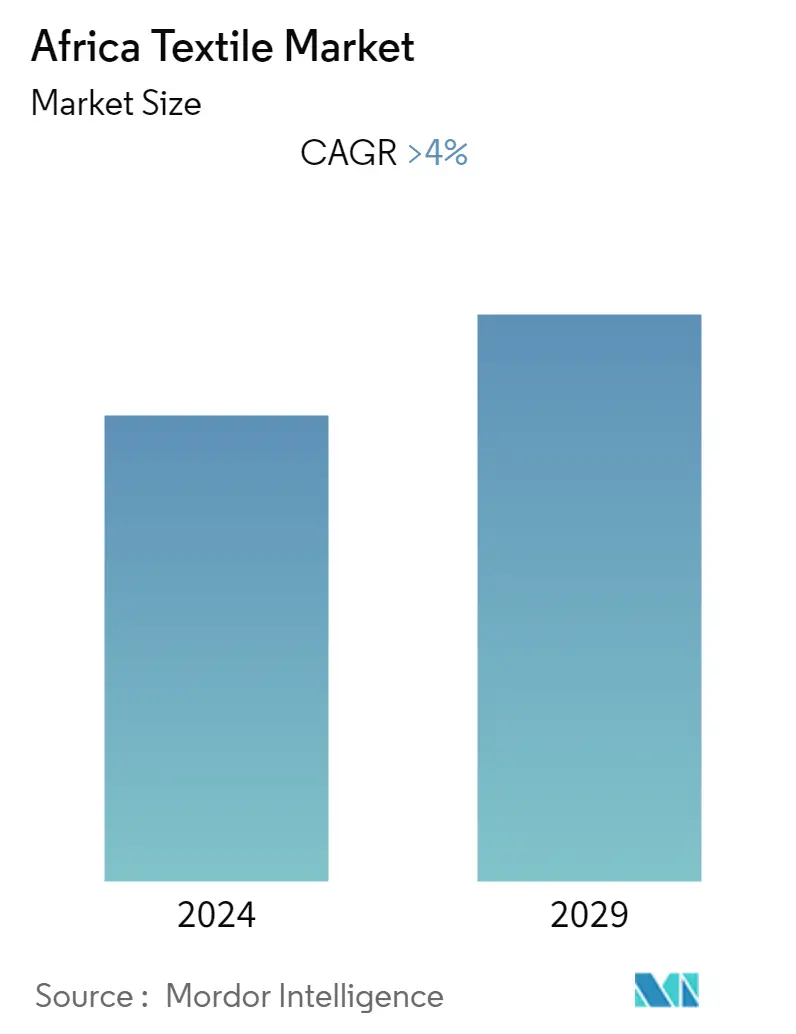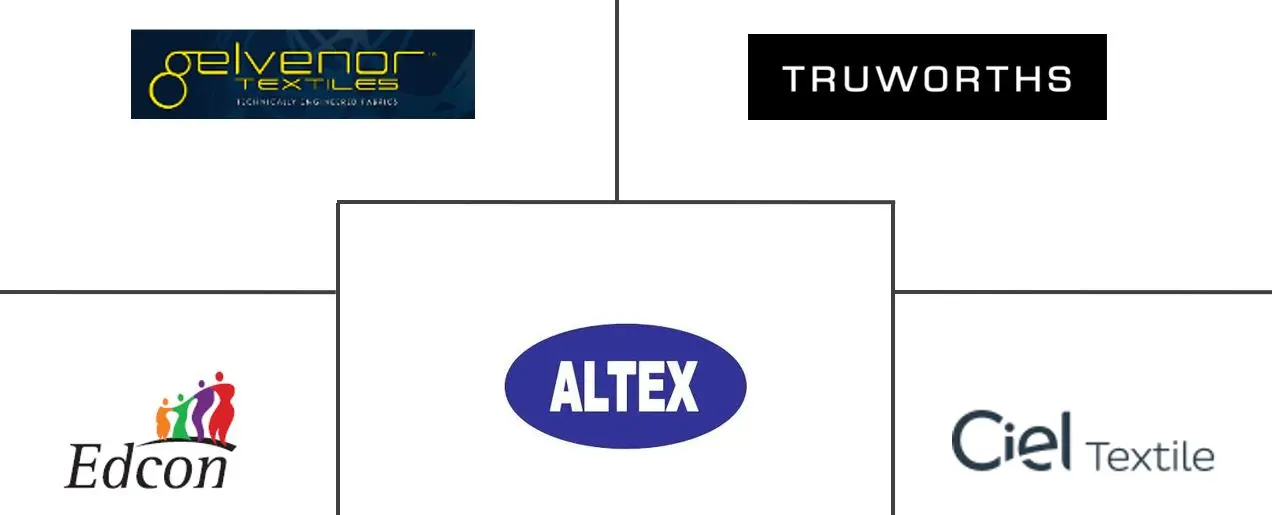Market Size of Africa Textile Industry

| Study Period | 2020 - 2029 |
| Base Year For Estimation | 2023 |
| Forecast Data Period | 2024 - 2029 |
| Historical Data Period | 2020 - 2022 |
| CAGR | > 4.00 % |
| Market Concentration | Low |
Major Players
*Disclaimer: Major Players sorted in no particular order |
Africa Textile Market Analysis
The African textile industry is a varied one, but the seeming constant is their cotton market. There are many countries in Africa that currently grow and sell cotton. Six of them grow cotton under the label ''Cotton made by Africa'', which is one of the largest job producers as well, with 450,000 Africans working in the cotton business alone. The growing and selling of cotton is not their only textile industry though. South Africa has also gotten into technical textiles as well, by providing hemp to aeronautics companies for their products. Countries like Ethiopia are also starting to gain textile mills which employ locals and help businesses trying to escape the rising wages in countries like China. Companies like H&M have opened mills in Africa, since their wages are less, and the population can support the workers needed. They also create products like thread and yarn for global markets from cotton is grown and harvested in Africa.
The disruption of the COVID-19 pandemic on global value chains and its impact on African businesses is already evident. The pandemic and global economic lockdowns have had an immediate effect on textile production, sales, and trade. There has been a significant expansion in ecommerce and online shopping because of the lockdown. Clothing is a major and rapidly growing product category for ecommerce, but textiles are a rather niche online segment.
Africa Textile Industry Segmentation
A complete background analysis of the Africa Textile Industry, which includes an assessment of the parental market, emerging trends by segments and regional markets, significant changes in market dynamics, and market overview, is covered in the report. The Market is Segmented By Application Type (Clothing, Industrial/Technical Applications, and Household Applications), By Material Type (Cotton, Jute, Silk, Synthetics, and Wool), and By Process Type (Woven and Non-woven). The report offers Market Size and forecasts for Africa Textile Market in Value (USD Billion) for all the above segments.
| Application | |
| Clothing | |
| Industrial/Technical Applications | |
| Household Applications |
| Material Type | |
| Cotton | |
| Jute | |
| Silk | |
| Synthetics | |
| Wool |
| Process | |
| Woven | |
| Non-woven |
Africa Textile Market Size Summary
The African textile industry is diverse, with a significant focus on cotton production, which remains a cornerstone of the sector. Countries like South Africa and Ethiopia are expanding their textile capabilities, with South Africa venturing into technical textiles and Ethiopia attracting foreign investment due to its competitive labor costs. The industry has seen increased interest from global companies like H&M, which have established operations in Africa to leverage these advantages. The COVID-19 pandemic has disrupted global supply chains, impacting textile production and trade, while also accelerating the growth of e-commerce, with clothing becoming a prominent category. The African Growth and Opportunity Act (AGOA) has been instrumental in providing African textile exporters with duty-free access to the U.S. market, enhancing their competitive edge over non-eligible countries.
The African textile market is experiencing a surge in demand, with African designs gaining international recognition and integration into global fashion collections. Chinese investment in African textiles, particularly in Ethiopia, is on the rise, driven by improved infrastructure and the potential for increased productivity. The end of the quota system in industrial nations has opened up new markets for African textiles, further boosting the industry's growth prospects. Major international players dominate the market, but technological advancements and product innovation are enabling mid-size and smaller companies to expand their presence. The launch of new retail chains, such as Truworths' Primark, highlights the industry's focus on tapping into budget clothing markets, catering to lower-income consumers.
Africa Textile Market Size - Table of Contents
-
1. MARKET INSIGHTS AND DYNAMICS
-
1.1 Market Overview
-
1.2 Market Drivers
-
1.3 Market Restraints
-
1.4 Value Chain / Supply Chain Analysis
-
1.5 Porters Five Force Analysis
-
1.5.1 Threat of New Entrants
-
1.5.2 Bargaining Power of Buyers/Consumers
-
1.5.3 Bargaining Power of Suppliers
-
1.5.4 Threat of Substitute Products
-
1.5.5 Intensity of Competitive Rivalry
-
-
1.6 Impact of COVID-19 on the Market
-
-
2. MARKET SEGMENTATION
-
2.1 Application
-
2.1.1 Clothing
-
2.1.2 Industrial/Technical Applications
-
2.1.3 Household Applications
-
-
2.2 Material Type
-
2.2.1 Cotton
-
2.2.2 Jute
-
2.2.3 Silk
-
2.2.4 Synthetics
-
2.2.5 Wool
-
-
2.3 Process
-
2.3.1 Woven
-
2.3.2 Non-woven
-
-
Africa Textile Market Size FAQs
What is the current Africa Textile Market size?
The Africa Textile Market is projected to register a CAGR of greater than 4% during the forecast period (2024-2029)
Who are the key players in Africa Textile Market?
CIEL Textile Ltd., Almeda Textile Factory Plc, Edcon, Truworths and Gelvenor Textiles are the major companies operating in the Africa Textile Market.

